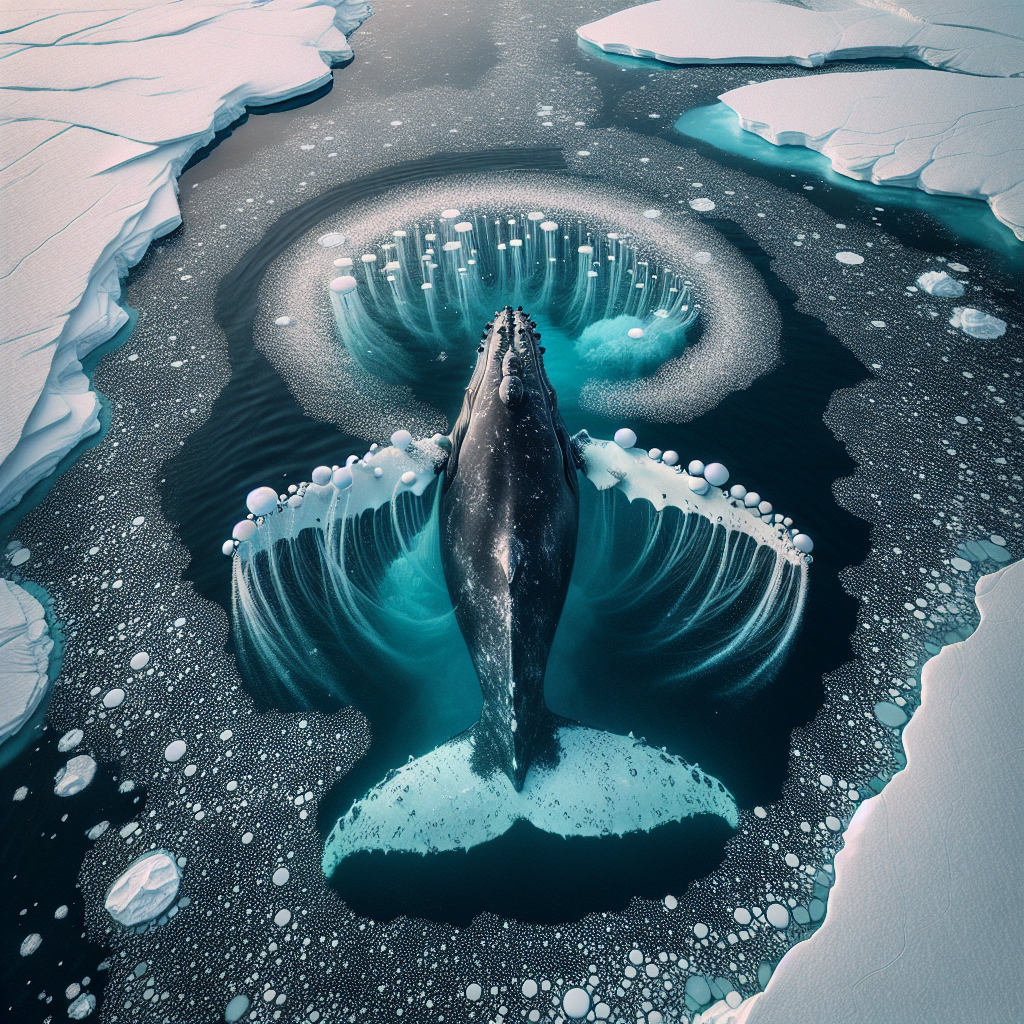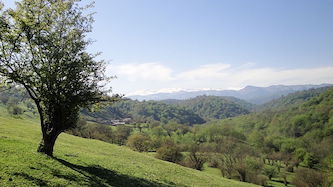Drones have provided new insights into the behavior of humpback whales in the Antarctic. The footage captured by BBC News and scientists shows how these whales use their bodies to create a “bubble net” to trap their prey. The whales use their long fins to sweep a net of bubbles around their prey, demonstrating their adaptability and creativity. Humpback whales are known for their acrobatic nature, and they are the only species known to produce these solitary “bubble nets.” The use of drone cameras has revolutionized scientists’ ability to study this behavior in detail.
The aerial view provided by drones has also shed light on the recovery of whale populations in areas where they were once hunted to near extinction. Researchers, including those from the British Antarctic Survey, have used drones to study whales in South Georgia, a key location for the whaling industry in Antarctica. The footage captured the first drone footage of a mother-calf pair of southern right whales off the coast of South Georgia, indicating that these populations are slowly recovering. The researchers also filmed an Antarctic blue whale mother and calf, the largest animals on Earth, feeding in the same area.
Drones have also been used to measure the bodies of whales, revealing evidence that some whales are shrinking due to climate change affecting their food supplies. A study published in the journal Global Change Biology showed that gray whales off the Pacific Northwest coast have shrunk by about 13% in the last two decades. This could be an early warning sign of population decline or poor health. Size is critical for animals as it affects their behavior, physiology, and the ecosystem they are a part of.
In addition to monitoring threats to whales, drones have captured fascinating marine mammal behavior. Filming humpback whales working together to feed has provided insight into how these animals learn and cooperate. In Antarctica, multiple animals are seen blowing bubbles at the same time, suggesting that they are still learning the feeding technique and have not yet refined it to give each animal a specific role. The footage also shows humpbacks spinning, circling boats, and interacting with other species, which could be described as “play.” This behavior strengthens social bonds and is critical for the well-being of these animals.
Overall, the use of drones has revolutionized the study of whales, providing new insights into their feeding behavior, population recovery, and response to climate change. The aerial view provided by drones has allowed scientists to observe and understand these magnificent creatures in ways that were not possible before.
Original news source: Drones reveal Antarctic whale ‘acrobatics’ (BBC)
🎧 Listen:
Slow
Normal
Fast
📖 Vocabulary:
| 1 | insights | Deep understanding or perception of a situation or subject |
| 2 | adaptability | The ability to change or be changed to fit new circumstances |
| 3 | acrobatic | Performing, involving, or adept at spectacular gymnastic feats |
| 4 | revolutionized | Completely changed the way something is done or understood |
| 5 | extinction | The state of being completely wiped out or destroyed |
| 6 | recovery | The process of returning to a normal state of health, mind, or strength |
| 7 | population | All the inhabitants of a particular area or species |
| 8 | physiology | The branch of biology that deals with the normal functions of living organisms and their parts |
| 9 | ecosystem | A biological community of interacting organisms and their physical environment |
| 10 | monitoring | Observing and checking the progress or quality of something over a period of time |
| 11 | fascinating | Extremely interesting and capturing attention |
| 12 | cooperate | Work jointly towards the same end |
| 13 | refined | Improved or made more precise |
| 14 | critical | Of the greatest importance; essential |
| 15 | magnificent | Extremely beautiful, elaborate, or impressive |
Group or Classroom Activities
Warm-up Activities:
– News Summary
Instructions: Divide the class into pairs or small groups. Give each group a few minutes to read the article. Then, ask each group to summarize the main points of the article in one or two sentences. Have each group share their summaries with the class and compare the different perspectives.
– Word Association
Instructions: Write the word “whales” on the board. Ask the students to brainstorm as many words or phrases associated with whales as they can in two minutes. After the time is up, go around the class and have each student share one word or phrase they came up with. Write all the words on the board and discuss their meanings and connections to the article.
– Sketch It
Instructions: Divide the class into pairs or small groups. Assign each group a specific scene or behavior mentioned in the article (e.g. humpback whales using bubble nets, whales blowing bubbles, etc.). Give the groups a few minutes to discuss and plan how they will sketch or draw their assigned scene. Afterward, have each group present their sketches to the class and explain the significance of the scene they depicted.
– Vocabulary Pictionary
Instructions: Choose about 10 key vocabulary words from the article (e.g. adaptability, acrobatic, extinct, etc.) and write each word on a separate index card. Divide the class into two teams. Choose a student from the first team to come to the front of the class. Show them a vocabulary word and have them draw it on the board without speaking or writing any letters or numbers. The student’s team must guess the word within a certain time limit (e.g. one minute). Repeat the process with a student from the second team. Continue alternating between teams until all the vocabulary words have been used.
– Pros and Cons
Instructions: Divide the class into two groups. Assign one group to list the pros (benefits) of using drones to study whales, and assign the other group to list the cons (disadvantages) of using drones. Give the groups a few minutes to brainstorm and discuss their ideas. Then, have each group share their lists with the class and facilitate a discussion comparing the different perspectives. Encourage the students to critically analyze and evaluate the arguments presented.
🤔 Comprehension Questions:
1. How do humpback whales use their bodies to create a “bubble net” to trap their prey?
2. What makes humpback whales unique in their ability to produce solitary “bubble nets”?
3. How have drones helped researchers study the recovery of whale populations in areas where they were once hunted?
4. What did the drone footage capture off the coast of South Georgia?
5. What evidence has been revealed about the size of gray whales off the Pacific Northwest coast?
6. Why is size critical for animals like whales?
7. What insights have been gained from filming humpback whales working together to feed?
8. How has the use of drones revolutionized the study of whales?
Go to answers ⇩
🎧✍️ Listen and Fill in the Gaps:
Drones have provided new insights into the behavior of humpback whales in the Antarctic. The footage captured by BBC News and scientists shows how these whales use their bodies to create a “bubble net” to trap their prey. The whales use their long fins to sweep a net of bubbles around their prey, (1)______ their (2)______ and (3)______. Humpback whales are known for their (4)______ nature, and they are the only species known to produce these solitary “bubble nets.” The use of drone cameras has revolutionized scientists’ ability to study this behavior in detail.
The aerial view provided by drones has also shed light on the recovery of whale populations in areas where they were once hunted to near extinction. Researchers, including those from the British Antarctic Survey, have used (5)______ to study whales in South Georgia, a key (6)______ for the whaling industry in Antarctica. The footage captured the first drone footage of a mother-calf pair of southern right whales off the coast of South Georgia, (7)______ that these populations are slowly recovering. The researchers also filmed an Antarctic blue whale mother and calf, the largest animals on Earth, (8)______ in the same area.
Drones have also been used to measure the bodies of whales, revealing evidence that some whales are shrinking due to climate change affecting their food supplies. A study published in the (9)______ Global Change Biology showed that gray whales off the (10)______ Northwest coast have shrunk by about 13% in the last two decades. This could be an early warning sign of population decline or poor health. Size is critical for animals as it affects their behavior, (11)______, and the ecosystem they are a part of.
In addition to monitoring (12)______ to whales, drones have captured fascinating marine mammal behavior. Filming humpback whales working together to feed has provided insight into how these animals learn and cooperate. In Antarctica, multiple animals are seen blowing bubbles at the same time, suggesting that they are still learning the feeding technique and have not yet refined it to give each animal a specific role. The footage also (13)______ humpbacks spinning, circling boats, and interacting with (14)______ species, which could be described as “play.” This behavior (15)______ social bonds and is critical for the well-being of these animals.
Overall, the use of drones has revolutionized the study of whales, providing new insights into their feeding behavior, population recovery, and response to climate (16)______. The aerial view provided by drones has allowed scientists to observe and understand these magnificent creatures in ways that were not possible before.
Go to answers ⇩
💬 Discussion Questions:
Students can ask a partner these questions, or discuss them as a group.
1. What is a “bubble net” and how do humpback whales use it to trap their prey?
2. How would you feel if you were able to observe humpback whales using a drone camera? Why?
3. Do you like the idea of using drones to study and monitor whale populations? Why or why not?
4. Do you think it’s important to study and understand the behavior of whales? Why or why not?
5. What other marine animals do you think could benefit from drone technology for research and observation? Why?
6. How do you think the use of drones has changed the way scientists study and monitor whale populations?
7. Why do you think the recovery of whale populations is significant? How does it impact the ecosystem?
8. Do you think the use of drones to measure the bodies of whales is an effective way to monitor their health? Why or why not?
9. How would you feel if you discovered that whale populations were shrinking due to climate change? Why?
10. What do you think can be done to protect and preserve whale populations from the effects of climate change?
11. Why do you think it’s important for animals to learn and cooperate with each other, like the humpback whales blowing bubbles together?
12. How do you think the behavior of humpback whales, such as spinning and interacting with other species, contributes to their well-being?
13. Do you think the use of drones in studying whales could have any negative impacts on the animals or their habitats? Why or why not?
14. How do you think the use of drones in studying whales compares to traditional research methods? Which do you think is more effective? Why?
15. Why do you think it’s important for humans to understand and appreciate the behavior of whales and other marine mammals?
Individual Activities
📖💭 Vocabulary Meanings:
Match each word to its meaning.
Words:
1. insights
2. adaptability
3. acrobatic
4. revolutionized
5. extinction
6. recovery
7. population
8. physiology
9. ecosystem
10. monitoring
11. fascinating
12. cooperate
13. refined
14. critical
15. magnificent
Meanings:
(A) Work jointly towards the same end
(B) The branch of biology that deals with the normal functions of living organisms and their parts
(C) Observing and checking the progress or quality of something over a period of time
(D) All the inhabitants of a particular area or species
(E) Performing, involving, or adept at spectacular gymnastic feats
(F) A biological community of interacting organisms and their physical environment
(G) Deep understanding or perception of a situation or subject
(H) The state of being completely wiped out or destroyed
(I) Extremely beautiful, elaborate, or impressive
(J) Of the greatest importance; essential
(K) Improved or made more precise
(L) Extremely interesting and capturing attention
(M) The ability to change or be changed to fit new circumstances
(N) The process of returning to a normal state of health, mind, or strength
(O) Completely changed the way something is done or understood
Go to answers ⇩
🔡 Multiple Choice Questions:
1. What behavior do humpback whales demonstrate when using their long fins to create a “bubble net”?
(a) Spinning and circling boats
(b) Interacting with other species
(c) Sweeping a net of bubbles around their prey
(d) Blowing bubbles at the same time
2. What has the use of drones revealed about whale populations in areas where they were once hunted?
(a) They are declining rapidly
(b) They are staying the same
(c) They are slowly recovering
(d) There is not enough data to determine
3. What is the largest animal on Earth?
(a) Southern right whale
(b) Antarctic blue whale
(c) Humpback whale
(d) Gray whale
4. What evidence has been revealed by drones about the size of gray whales off the Pacific Northwest coast?
(a) They have shrunk by about 13% in the last two decades
(b) They have grown by about 13% in the last two decades
(c) They have stayed the same size in the last two decades
(d) There is not enough data to determine
5. What does the behavior of humpback whales blowing bubbles at the same time suggest?
(a) They have already perfected the feeding technique
(b) They are competing for food
(c) They are communicating with each other
(d) They are still learning the feeding technique
6. What does the article say about the use of drones in studying whales?
(a) It has had no impact on the study of whales
(b) It has made studying whales more difficult
(c) There is not enough data to determine
(d) It has revolutionized the study of whales
7. What is the main focus of the study published in the journal Global Change Biology?
(a) The behavior of humpback whales in Antarctica
(b) The shrinking size of gray whales due to climate change
(c) The recovery of whale populations in South Georgia
(d) The use of drones in studying whales
8. What is the importance of size for animals, according to the article?
(a) It affects their behavior, physiology, and the ecosystem they are a part of
(b) It has no impact on animals
(c) It only affects their behavior
(d) There is not enough data to determine
Go to answers ⇩
🕵️ True or False Questions:
1. Drones have been used to capture footage of humpback whales using their bodies to create a “bubble net” to trap their prey.
2. Filming humpback whales working together to feed has provided insight into how these animals learn and cooperate.
3. Drones have provided an aerial view that has shed light on the recovery of whale populations in areas where they were once hunted to near extinction.
4. The use of drone cameras has not revolutionized scientists’ ability to study whale behavior in detail.
5. Drones have failed to measure the bodies of whales, revealing no evidence of shrinking due to climate change affecting their food supplies.
6. Gray whales off the Pacific Northwest coast have shrunk by about 13% in the last two decades, potentially indicating population decline or poor health.
7. Drones failed to capture the first footage of a mother-calf pair of southern right whales off the coast of South Georgia, indicating population decline.
8. Humpback whales are not the only species known to produce solitary “bubble nets.”
Go to answers ⇩
📝 Write a Summary:
Write a summary of this news article in two sentences.
Check your writing now with the best free AI for English writing!
Writing Questions:
Answer the following questions. Write as much as you can for each answer.
Check your answers with our free English writing assistant!
1. How do humpback whales use their bodies to create a “bubble net” to trap their prey?
2. What has the use of drone cameras revealed about the recovery of whale populations in areas where they were once hunted?
3. What evidence has been found that suggests some whales are shrinking due to climate change affecting their food supplies?
4. What insight has the filming of humpback whales working together to feed provided?
5. How has the use of drones revolutionized the study of whales?
✅ Answers
🤔✅ Comprehension Question Answers:
1. Humpback whales use their long fins to sweep a net of bubbles around their prey, creating a “bubble net” to trap them.
2. Humpback whales are the only species known to produce solitary “bubble nets,” making them unique in their ability to use this feeding technique.
3. Drones have helped researchers study the recovery of whale populations by providing aerial views and footage of whale behavior in areas where they were once hunted, such as South Georgia.
4. The drone footage captured the first footage of a mother-calf pair of southern right whales off the coast of South Georgia, indicating the recovery of these populations.
5. The drone footage revealed that gray whales off the Pacific Northwest coast have shrunk by about 13% in the last two decades.
6. Size is critical for animals like whales because it affects their behavior, physiology, and the ecosystem they are a part of.
7. Filming humpback whales working together to feed has provided insight into how these animals learn and cooperate. The footage showed that multiple animals are still learning the feeding technique of blowing bubbles at the same time and have not yet refined it to give each animal a specific role.
8. The use of drones has revolutionized the study of whales by providing new insights into their feeding behavior, population recovery, and response to climate change. The aerial view provided by drones has allowed scientists to observe and understand whales in ways that were not possible before.
Go back to questions ⇧
🎧✍️✅ Listen and Fill in the Gaps Answers:
(1) demonstrating
(2) adaptability
(3) creativity
(4) acrobatic
(5) drones
(6) location
(7) indicating
(8) feeding
(9) journal
(10) Pacific
(11) physiology
(12) threats
(13) shows
(14) other
(15) strengthens
(16) change
Go back to questions ⇧
📖💭✅ Vocabulary Meanings Answers:
1. insights
Answer: (G) Deep understanding or perception of a situation or subject
2. adaptability
Answer: (M) The ability to change or be changed to fit new circumstances
3. acrobatic
Answer: (E) Performing, involving, or adept at spectacular gymnastic feats
4. revolutionized
Answer: (O) Completely changed the way something is done or understood
5. extinction
Answer: (H) The state of being completely wiped out or destroyed
6. recovery
Answer: (N) The process of returning to a normal state of health, mind, or strength
7. population
Answer: (D) All the inhabitants of a particular area or species
8. physiology
Answer: (B) The branch of biology that deals with the normal functions of living organisms and their parts
9. ecosystem
Answer: (F) A biological community of interacting organisms and their physical environment
10. monitoring
Answer: (C) Observing and checking the progress or quality of something over a period of time
11. fascinating
Answer: (L) Extremely interesting and capturing attention
12. cooperate
Answer: (A) Work jointly towards the same end
13. refined
Answer: (K) Improved or made more precise
14. critical
Answer: (J) Of the greatest importance; essential
15. magnificent
Answer: (I) Extremely beautiful, elaborate, or impressive
Go back to questions ⇧
🔡✅ Multiple Choice Answers:
1. What behavior do humpback whales demonstrate when using their long fins to create a “bubble net”?
Answer: (c) Sweeping a net of bubbles around their prey
2. What has the use of drones revealed about whale populations in areas where they were once hunted?
Answer: (c) They are slowly recovering
3. What is the largest animal on Earth?
Answer: (b) Antarctic blue whale
4. What evidence has been revealed by drones about the size of gray whales off the Pacific Northwest coast?
Answer: (a) They have shrunk by about 13% in the last two decades
5. What does the behavior of humpback whales blowing bubbles at the same time suggest?
Answer: (d) They are still learning the feeding technique
6. What does the article say about the use of drones in studying whales?
Answer: (d) It has revolutionized the study of whales
7. What is the main focus of the study published in the journal Global Change Biology?
Answer: (b) The shrinking size of gray whales due to climate change
8. What is the importance of size for animals, according to the article?
Answer: (a) It affects their behavior, physiology, and the ecosystem they are a part of
Go back to questions ⇧
🕵️✅ True or False Answers:
1. Drones have been used to capture footage of humpback whales using their bodies to create a “bubble net” to trap their prey. (Answer: True)
2. Filming humpback whales working together to feed has provided insight into how these animals learn and cooperate. (Answer: True)
3. Drones have provided an aerial view that has shed light on the recovery of whale populations in areas where they were once hunted to near extinction. (Answer: True)
4. The use of drone cameras has not revolutionized scientists’ ability to study whale behavior in detail. (Answer: False)
5. Drones have failed to measure the bodies of whales, revealing no evidence of shrinking due to climate change affecting their food supplies. (Answer: False)
6. Gray whales off the Pacific Northwest coast have shrunk by about 13% in the last two decades, potentially indicating population decline or poor health. (Answer: True)
7. Drones failed to capture the first footage of a mother-calf pair of southern right whales off the coast of South Georgia, indicating population decline. (Answer: False)
8. Humpback whales are not the only species known to produce solitary “bubble nets.” (Answer: False)
Go back to questions ⇧













